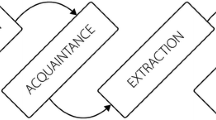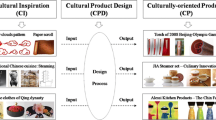Abstract
Training user experience (UX) design students to develop interactive products valuing the subjective experience as a catalyst is a challenge. Experience design implies a deep understanding of the values, culture, beliefs and practices of a target user group and also sensitivity to consciously integrate them in products with distinctive qualities. This paper presents a method experimented along three years of the Master’s Degree Program in Industrial Design at Eindhoven University of Technology. The method uses poems as cultural probes and as an access door to experience cultural elements and to embed them in the design of meaningful interactions. Beside the presentation of the method, the paper illustrates student projects that exemplify the approach. It concludes with recommendations to experience designers for transforming socio-cultural factors into product features which promote a valuable subjective experience.
Access this chapter
Tax calculation will be finalised at checkout
Purchases are for personal use only
Similar content being viewed by others
References
Law, E., Roto, V., Vermeeren, A., Kort, J., Hassenzahl, M.: Towards a shared definition of user experience (UX). Proc. CHI 5(10) (2008)
Roto, V., Law, E., Vermeeren, A., Hoonhout, J.: User Experience White Paper—Bringing Clarity to the Concept of User Experience. All About UX (2011)
Marti, P., Iacono, I.: Experience over time: evaluating the experience of use of an interactive device on the short and medium term. Int. J. Multimedia Tools Appl. 76(4), 5095–5116 (2017)
Glanznig, M.: User experience research: modelling and describing the subjective. Interdisc. Descr. Complex Syst. 10(3), 235–247 (2012)
Hassenzahl, M.: Experience Design: Technology for All the Right Reasons. Morgan and Claypool Publishers, Essen (2010)
Wright, P., McCarthy, J.: Experience-Centered Design: Designers, Users, and Communities in Dialogue. Morgan and Claypool Publishers (2010)
Norman, D. 2002. Emotion & design: attractive things work better. Interactions 9(4), 36–42 (2002)
Scheirer, J., Fernandez, R., Klein, J., Picard, R.: Frustrating the user on purpose: using biosignals in a pilot study to detect the user’s emotional state. In: Cockton, G. (ed.) CHI 98 Conference Summary on Human Factors in Computing Systems (CHI ‘98). Special issue of Interacting with Computers, vol. 14, pp. 93–118. Elsevier, Amsterdam (1998)
Overbeeke, C., Djajadiningrat, J., Hummels, C., Wensveen, S.: Beauty in usability—forget about ease of use! In: Green, W., Jordan, P. (eds.) Pleasure with Products: Beyond Usability, pp. 9–18. Taylor and Francis Ltd., London (2002)
Dunne, T., Raby, F.: Design Noir: the Secret Life of Electronic Products, 1st edn. Birkhäuser Verlag (2001)
Gaver, W.: What should we expect from research through design? In: Proceedings of CHI ‘12, pp. 937–946. ACM Press, New York (2012)
Graves Petersen, M., Iversen, O., Krogh, P., Ludvigsen, M.: Aesthetic interaction: a pragmatist’s aesthetics of interactive systems. In: Proceedings of the 5th Conference on Designing Interactive Systems: Processes, Practices, Methods, and Techniques (DIS ‘04), pp. 269–276. ACM, New York (2004)
Gaver, B., Dunne, T., Pacenti, E.: Design: cultural probes. Interactions 6(1), 21–29 (1999)
Crabtree, A., Hemmings, T., Roddon, T., Cheverst, K., Clarke, K., Dewsbury, G., Hughes, J., Rouncefield, M.: Designing with care: adapting cultural probes to inform design in sensitive settings. In: Proceedings of OzCHI, pp. 4–13. Ergonomics Society of Australia, Brisbane (2003)
Peeters, M., Megens, C., Hummels, C., Brombacher, A.: Experiential probes: probing for emerging behaviour patterns in everyday life. In: Proceedings of the 5th International Congress of International Association of Societies of Design Research, pp. 26–30. IASDR, Tokio (2013)
Buchenau, M., Fulton-Suri, J.: Experience prototyping. In: Boyarski, D., Kellogg, W. (eds.) DIS 2000, pp. 424–433. ACM, New York (2000)
Mattelmäki, T., Battarbee, K.: Empathy probes. In: Proceedings of the Participatory Design Conference, pp. 266–271. PDC, Malmö (2002)
Mattelmäki, T.: Design Probes. University of Art and Design Helsinki, Helsinki (2006)
Marti, P., van der Houwen, W.: Poetry as a cross-cultural analysis and sensitizing tool in design. AI Soc. 1–14. Springer, London (2017). ISSN: 0951-5666, https://doi.org/10.1007/s00146-017-0721-8, https://springerlink.bibliotecabuap.elogim.com/article/10.1007/s00146-017-0721-8
Acknowledgements
The authors thank Gijs de Boer, Tove Elfferich, John Vlaming from the ‘Teh Lampu’ project group and Xihao Hu, Bram Rutten and Xander Meijering, from ‘the Dear Enclosure’ project group for their contributions. A special thanks to Jan Glas for his didactic poetry skills and to Ward van der Houwen co-lecturer of ‘Poetry in Design’.
Author information
Authors and Affiliations
Corresponding author
Editor information
Editors and Affiliations
Rights and permissions
Copyright information
© 2020 Springer Nature Singapore Pte Ltd.
About this paper
Cite this paper
Marti, P., van Leiden, F. (2020). Teaching Experience Design Using Poems as Cultural Probes. In: Rehm, M., Saldien, J., Manca, S. (eds) Project and Design Literacy as Cornerstones of Smart Education. Smart Innovation, Systems and Technologies, vol 158. Springer, Singapore. https://doi.org/10.1007/978-981-13-9652-6_2
Download citation
DOI: https://doi.org/10.1007/978-981-13-9652-6_2
Published:
Publisher Name: Springer, Singapore
Print ISBN: 978-981-13-9651-9
Online ISBN: 978-981-13-9652-6
eBook Packages: Intelligent Technologies and RoboticsIntelligent Technologies and Robotics (R0)




